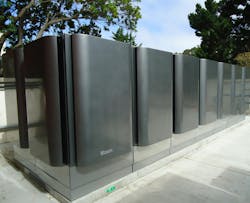Quanta Technologies Factory to be Powered by Bloom Energy Fuel Cell Microgrid
Bloom Energy and electronics manufacturer Quanta Technologies have expanded on their agreement to power the latter’s hardware manufacturing facility in California with a fully islandable fuel cell microgrid.
Quanta creates technology for the artificial intelligence (AI) sector, which is growing exponentially and driving an expansion in data center capacity over the coming decade. Bloom Energy is deploying its solid oxide fuel cell (SOFC) solution to power the microgrid.
The new agreement, building on an original announcement last April, will pave the way for Bloom expanding its existing SOFC installation by 150% and will avoid a costly utility interconnection delay to help Quanta keep up with rising orders in AI-related equipment.
Fuel cells convert a fuel into electricity via an electrochemical process. The fuel cell itself does not emit greenhouse gases.
The fuel cell microgrid is designed to help power Quanta’s manufacturing expansion in Fremont, California. The company’s growth plans were impeded by interconnection delays in increasing grid power by local utilities, so Quanta selected Bloom Energy for an on-site power solution.
“Leaders in the AI industry like Quanta simply do not enjoy the luxury of being able to wait for traditional grid infrastructure, because the marketplace won’t wait for them,” said Aman Joshi, Bloom Energy’s global Chief Commercial Officer, in a statement. “Bloom’s SOFC microgrids provide AI customers with a flexible, pay-as-you-grow solution that is ready to scale and avoids additional transmission or distribution upgrades. This effectively shortens interconnection permitting associated with traditional infrastructures.”
Quanta supplies high-powered servers for AI computations. The tech provider leases and operates out of several industrial buildings in Fremont, according to reports.
Owners of data centers and other facilities with large loads are increasingly talking to microgrid providers about building off-grid microgrids to ensure they have electricity when utilities are power-strapped or when utilities can’t provide interconnection in a timely manner.
“We are seeing a lot of microgrid providers of natural gas solutions or fuel cells offering a 24/7 solution for these larger loads to address utility constraints,” Elham Akhavan, senior microgrid research analyst at Wood Mackenzie, told Microgrid Knowledge earlier this year. “It wasn’t the case before; this is just happening now.”
Data center capacity, driven by AI, will require close to 50 GW of additional power by the end of this decade, according to Goldman Sachs and other reports. Tech giants such as Microsoft and Google are seeking carbon-free resources to meet that load, including solar, battery storage, hydrogen, hydropower, wind and nuclear.
From NA+ to Volcanic Geothermal and Nuclear Fusion
Our new EnergyTech E-Book on Innovations and Experimentation in the Energy Transition
